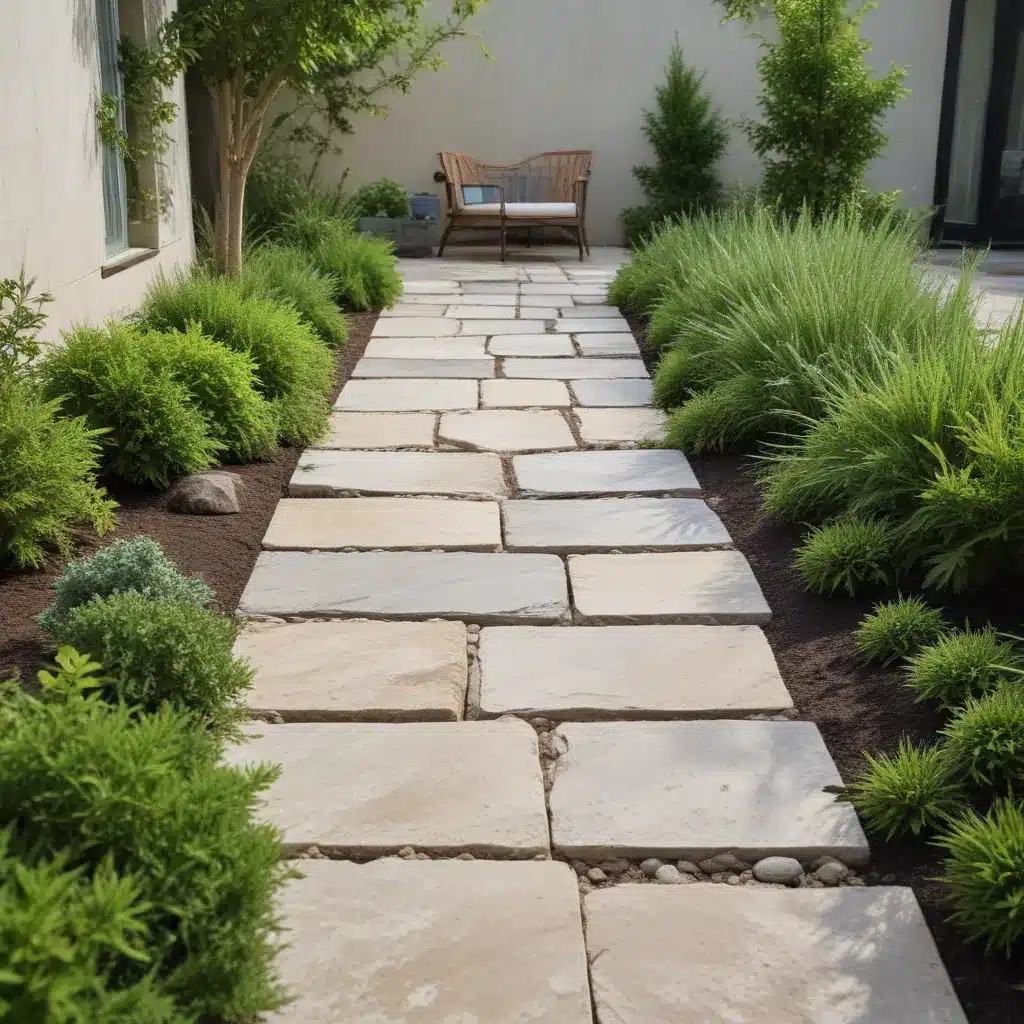
Crafting Durable and Environmentally Conscious Outdoor Spaces
As a seasoned construction professional and interior designer, I’ve spent years honing my expertise in creating functional and aesthetically pleasing outdoor living spaces. One aspect that has become increasingly important in my work is the use of sustainable hardscaping materials for patios, walkways, and other landscape features. In this comprehensive article, I’ll share my insights on selecting eco-friendly options that not only enhance the beauty of your property but also support long-term environmental sustainability.
Understanding the Difference: Walkways vs. Pathways
When designing your outdoor spaces, it’s crucial to grasp the distinction between walkways and pathways, as each serves a different purpose and can be constructed using various materials.
Walkways are designed for regular foot traffic, often connecting key areas like the driveway to the front door or the backyard to the garage. These are typically more formal and structured, with common materials including:
- Pavers
- Concrete
- Natural stone (e.g., flagstone, slate, or limestone)
- Brick
Pathways, on the other hand, are more casual and meandering, often found in gardens or less trafficked areas. They are designed to blend with the natural landscape and guide visitors through your yard. Common materials for pathways include:
- Mulch
- Crushed stone
- Wood chips
- Decomposed granite
The choice between a walkway or a pathway depends on the specific needs and aesthetic preferences of your outdoor space. Walkways are best suited for high-traffic areas and where a more formal look is desired, while pathways work well in garden settings or less formal areas where a softer, more natural appearance is preferred.
Sustainable Hardscaping Materials: Exploring Eco-Friendly Options
When it comes to creating sustainable outdoor spaces, the materials you choose for your hardscaping projects play a crucial role. Here are some eco-friendly options to consider:
Granite Leftovers
Leftover granite remnants from countertop companies can be an excellent choice for walkways and patios. These discarded materials are repurposed, reducing waste and giving your yard a unique, rustic look.
Permeable Pavers
Permeable pavers are designed to allow water to pass through, reducing runoff and promoting natural drainage. This makes them an ideal choice for eco-friendly landscapes, as they help manage stormwater and prevent water accumulation.
Crushed Stone and Mulch
Crushed stones and mulch are budget-friendly and natural-looking options for walkways and pathways. They offer several benefits for eco-conscious homeowners, as they are permeable, low-maintenance, and blend seamlessly with the surrounding landscape.
Recycled/Reclaimed Materials
Incorporating recycled or reclaimed materials, such as recycled rubber or plastic pavers, can significantly reduce the environmental impact of your hardscaping project. These options often provide excellent durability and a unique aesthetic.
Locally Sourced Materials
Choosing locally sourced materials, such as natural stone or wood from your region, can minimize the carbon footprint associated with transportation, further enhancing the sustainability of your outdoor space.
By selecting eco-friendly hardscaping materials, you can create beautiful and functional walkways and patios that support environmental sustainability, reduce water runoff, and seamlessly integrate with your landscape.
Designing Sustainable Walkways: Practical Tips and Inspiration
Crafting a walkway that is both functional and aesthetically pleasing can be a rewarding project. Here are some sustainable landscape walkway ideas to inspire your next outdoor transformation:
Stepping Stone Pathways
Stepping stone pathways are a popular choice for their charm and ease of installation. Flagstone is a favorite material due to its natural look and durability. You can lay flagstones flush with the grass, making it easy to mow over them.
Decorative Driveway Elements
Adding decorative elements to your driveway can enhance its appeal and functionality. DIY projects like creating unique driveway markers using leftover materials from countertop companies, such as granite bits, can be both fun and cost-effective.
Integrated Garden Walkways
Incorporating walkways into your garden or front yard can create a cohesive and inviting landscape. Paver patterns like herringbone or basketweave add visual interest and functionality, while also guiding visitors through your outdoor oasis.
Proper Installation Techniques
Ensuring the proper excavation, sand bedding, and drainage management is crucial for the long-term durability and functionality of your walkway. Adequate slope and the use of drainage pipes can prevent water accumulation and damage to your hardscaping.
By combining materials like flagstone, stepping stones, and decorative elements, you can design walkways that are both functional and attractive, while also supporting sustainable practices. Whether you’re undertaking a DIY project or seeking professional assistance, these ideas can elevate your landscape’s aesthetic and environmental impact.
Balancing Sustainability and Practicality
When it comes to creating sustainable and practical outdoor spaces, there’s no one-size-fits-all solution. The choice of hardscaping materials and design ultimately depends on your specific needs, budget, and environmental priorities.
Cost-Effective and Eco-Friendly Options
For those seeking a straightforward and budget-friendly approach, crushed stones and mulch can be excellent choices. These materials are not only economical but also highly permeable, promoting water drainage and reducing runoff.
Durable and Sustainable Alternatives
If you’re looking for a more robust and eco-friendly solution, permeable pavers and recycled/reclaimed materials offer long-lasting durability while supporting sustainable practices. These options can be more investment-intensive upfront but often pay dividends in the long run.
Blending Aesthetics and Function
Integrating sustainable hardscaping elements like stepping stones, decorative driveway markers, and seamless garden walkways can create a visually appealing outdoor space that also addresses environmental concerns. By carefully considering design, materials, and installation techniques, you can achieve a harmonious balance between beauty and functionality.
At Local Builder London, our team of experienced construction professionals and interior designers specializes in crafting exceptional outdoor living spaces that prioritize sustainability. We understand the importance of selecting the right hardscaping materials and design solutions to enhance your property’s curb appeal while also supporting long-term environmental responsibility.
Whether you’re planning a patio renovation, a walkway installation, or a complete landscape transformation, we’re here to guide you through the process, providing practical advice and customized solutions tailored to your needs. Contact us today to start your sustainable outdoor living journey.


